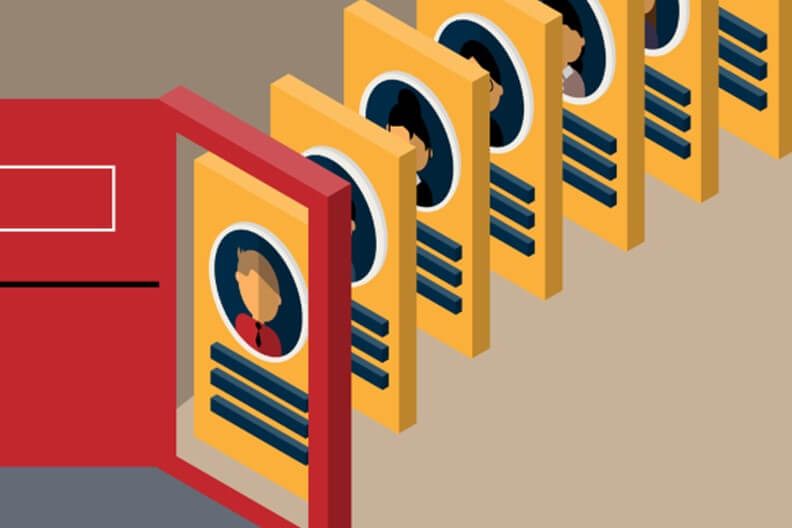This article includes historical information for context. While the core content remains valuable, some details reflect past events and may not be up to date. We regularly update our blog to keep you informed of current insights.
During the pandemic, tech companies had an ideal environment for rapid growth. Workers could work from home and classes could be taken online. Shopping could be managed through internet retailers and stores. Entertainment could be streamed into living rooms or on smart devices anywhere across the globe. Advertising agencies, search engines, and social media platforms were ripe to help organizations tap captive audiences to gain new customers.
The assumption was that demand for technology and virtual needs would continue for some time. When the restrictions of the pandemic ended and life returned to in-person lifestyles and business activities, the tech sector wasn’t prepared to handle the change. The high demands of sudden growth had not involved risk assessment and forecasting, let alone innovation, all critical for future sustainability.
The result: From March through November 2022, tech sector companies, including Twitter, Meta, Amazon, Netflix, Shopify, Zillow, Uber, Google, and others, made massive employment cuts. (1) As of December 2022, Layoffs.fyi reported that over 153,000 tech workers were laid off. By early 2023, nearly 20,000 had been added to the layoff count.
WHAT ARE THE REASONS BEHIND THE LAYOFFS?
- Focusing on Profitability – According to a public memo from CEO Anjali Sud, Vimeo decided to focus on profitability. (2)
- Divesting – Amazon hinted that experiments and tests that don’t translate to value of some kind may be a contributor to its recent job cutbacks. (9) Microsoft’s CEO, Satya Nadella wrote that it would be “…divesting in other areas.” (11) While unclear what the divesting specifics may be, Microsoft wouldn’t be the first company in history to refocus, evaluate, and reprioritize its goals for future growth. In 2015, Bayer divested from its chemicals and materials divisions which resulted in the pharmaceutical giant known today. (12)
- Reducing Costs – Snap laid off staff and canceled drone projects resulting in an estimated $500 million in savings per year. (3) Microsoft also announced plans to reduce its workforce by 10,000 jobs in an effort to align cost with revenue and demand projections. (11)
- Investing in Secular Growth – Noting that there were accelerated demands during the pandemic, but more cautious spending due to factors such as inflation, potential regulatory changes, etc., Microsoft re-evaluated its long-term opportunities. This resulted in a shift in focus of both capital and talent investments that would have long lasting impact, result in long-term competitiveness and lead to significant growth in the future. (11)
- Downsizing – Increased hiring demands because of the pandemic lockdown (e.g., remote working environments; increase in online activity such as entertainment streaming and retail; beliefs that virtual would overtake demand for in-person activities, etc.) spurred a hiring frenzy. However, post-pandemic, things began to return to normal. People weren’t staying at home, and companies that expected to see continued online growth, such as during the pandemic, slowed. (4) Additionally, concerns about economic conditions (e.g., inflation, rising interest rates, slowed growth, etc.) led to downsizing. (5)
- Anticipating “The Dark Winter” – Rising costs and inflation associated with energy, talent, and supply chains are a concern. Talent shortages due to a shift in priorities among employees post-pandemic is yet another top concern. (See “quiet quitting”) Additionally, new equipment and buildings are necessary to minimize the impact of threats of supply chain issues that come with evolving and hiked interest rates, yet these investments mean cutting costs somewhere else.
- Copycat Behavior – Mass layoffs, specific to just one sector, are often like a yawn. Pause for a moment. Humans are, by nature, a very social species, and some are more social than others. Naturally, when someone yawns, especially if accompanied by the “ahhh” sound effect, it’s likely to be more contagious. Ironically, workforce cutbacks can be similar in nature. If one or two larger companies in a specific sector start laying off staff in vast numbers, other organizations in the same sector may likely do so as a reactionary response. In other words, some organizations may simply follow with a layoff or firing plan by believing, “Hey, if they are doing something big, maybe they know something we don’t!”Stanford business Professor Jeffrey Pfeffer believes that “social contagion” is the cause of mass layoffs in the tech sector. And much like a yawn, some organizations are more susceptible to contagion while others are not. (6)
Do employee cutbacks help organizations?
The short answer is no.
The longer answer is that there are many myths surrounding employee layoffs. One large myth is the assumption that there will be savings. This might be true in some cases, but it isn’t always. Employees can be rehired, but as a contractor at a higher rate. Laying off new hires can result in unremunerated losses such as paid out sign-on bonuses, training, unemployment costs, etc., not to mention that down the road, businesses may be re-hiring those same people at a higher rate in the future. (6) Being without a job can cause anxiety, depression, loss of life satisfaction, and these feelings can remain even after new employment is found. (7)
Another myth is that when a company lays off employees, there will be an increase in productivity. The concept is that “trimming the fat,” will solve issues. Laying off employees is not a solution to what is frequently the problem. The workforce itself isn’t generally what is causing a decline. It’s more likely a failed strategy, loss of market share, or shrinking revenue. (6)
LESSONS THAT CAN BE LEARNED
Never Forget About Innovation – Fresh ideas are the heart of any thriving, sustainable business strategy. Giants in the tech sector have struggled to develop something truly innovative and unique. This leaves them vulnerable to more creative companies eager and driven to tap markets hungry for solutions and innovation. (8)
The lesson: It’s time to get back to the fundamentals that have impact on an organization’s success. Creating the space for innovation involves real transformation such as:
- Improving workplace productivity
- Motivating employees through appreciation and recognition
- Resolving issues with workforce efficiency
- Decreasing time spent troubleshooting
- Streamlining the supply chain
- Optimizing procurement processes
- Challenging the status quo
Keep Growth Strategies Agile – Assumptions about current trends can lead to stagnant (or even declining) growth strategies. The tech sector (as well as organizations investing in long-term tech strategies) thought that the growth would be sustainable because it was trending that way. They became overconfident and had poor insight, forecasting, etc. They didn’t consider the what-if scenarios. What if things returned to normal after the pandemic? What if the demand for certain types of technology declined? What if there were supply chain issues? The list goes on and on.
The lesson: Look at some of the historic swings and ask yourself, How did these impact growth and loss? In my industry or market sector? For leaders in my industry or market sector? For my organization?
- Post-second WWII expansion
- Technology expansion (1990-1999)
- Post dotcom bubble
- 9/11 (2002-2007)
- Post housing market crash (2008)
Then swing the pendulum the other direction. What industries or sectors benefited the most? What strategies did they use? What companies risked and won? What companies risked and lost? When some industries benefited from growth, what sectors were on the opposite end of the spectrum? (e.g., improvement for some may mean problems for others.)
For example – the tech sector boomed during the pandemic. However, post-pandemic, they are laying off workers. On the other hand, the hospitality and tourism sectors suffered during the pandemic, but now people are eager to enjoy in-person activities.
Asking the what-if scenarios question, studying historic growth and loss patterns, and observing pendulum swings can help create better strategies.
“Stop Doing Stupid Stuff” – Glen Kelman, CEO of Redfin Corp reflected on the rapid pandemic growth in an interview with the Wall Street Journal. His direct but frank response hit the mark that many CEOs across various sectors could relate to when pondering layoffs and downward profits. (9)
What examples did other executives mention that didn’t impact company growth? (9)
- Costly tests and experiments that don’t result in anything. (Contributed by Amazon’s Chief Executive Andy Jassy.)
- Ideas to delight customers. (Contributed by Redfin Corp’s CEO Glen Kelman)
- Over-hiring, despite knowing sustainability could be a problem in the future. (Contributed by Salesforces’ Co-CEO Marc Benioff) Sadly, Salesforce wasn’t alone. Meta’s Mark Zuckerberg, Redfin’s CEO Kelman, and Twitter’s founder and former CEO Jack Dorsey did the same as thousands of other companies.
The lesson: Ask yourself:
- Are we so excited about rapid growth that we haven’t considered long-term sustainability?
- Is what we are doing now leading to profit, value, or tangible ROI later? If not, then ask, why are we doing what we are doing? Would we be doing the same if we weren’t in a fast growth trajectory?
- Should we “slow our roll” even if it might mean we miss some opportunities now, but for the sake of stability in the future?
PLANNING FOR EMPLOYEE LAYOFFS
Reduce Layoff Anxiety – Employees can perceive high layoff activities within their department, company, or even industry with confirmation bias (misunderstanding behavior as proof of an outcome such as “the company is going under” or “the company is consolidating jobs” or something similar) with a sense of fear.
To minimize fear and anxiety, create a contingency plan BEFORE you get to that point. (10)
- Evaluate evidence such as whether your company is rolling out cost-saving measures, a change of focus, and/or implementing a hiring freeze, slower sales, or lighter workloads, etc. How will these changes impact employees?
- Plan for the what-if scenarios, such as what your response might be, what next steps you would take, what resources/tools you would need, and how you would help employees losing jobs to deal with obstacles such as insurance, healthcare, financial needs, job hunting, etc. Also, consider factors such as “employment guilt” for those employees who remain and what may be needed to keep morale high, and remaining employees engaged and loyal.
- Become mentally tough so that you can rebound faster. Resiliency is important but never more so than after a setback. Instead of focusing on the “what could have been,” review what you learned and how that benefits you. Establish this as a corporate culture. What strengths can you build on? How does this improve things for stakeholders, both those that remain and how can you help those who must leave? Employees should understand their value, importance, and role, especially when substantial changes happen.
- Help employees to avoid confusing who they are with what they do. They are much more than their role, job title, or responsibilities. Encourage them to spend time doing something other than work, such as enjoying time with family and friends, devoting time to hobbies or other things that round them out as a whole person.
Own the Changes – If you must lay off employees, you must. It may not be a pleasant task, but it should be done with honesty, humility, and self-reflection. Transparency with all stakeholders should be utilized whenever possible. Whatever the reason, to save money, you don’t need as many employees, or you’re changing the company’s focus, transparency is essential for morale and trust. Some real-world examples to review include:
- Vimeo’s focus on profitability
- Meta’s focus on savings and a smaller real estate footprint
- Microsoft’s aligning of cost structure with revenue and where customer demand exists, investing in strategic areas of growth, and divesting in other areas
Other things to consider when you discuss why you are cutting back the workforce include:
- What are the plans?
- What did you learn, and how will the company take a step forward with things known and in a fresh direction?
- How can you, as a leader and as an entire company with a culture, be humble, kind, and thoughtful as you make changes to the workforce?
This is not the first or last period of changes companies will have to face in their lifetime. By learning from other industries, such as the tech sector, your organization can be more thoughtful, insightful, agile, and successful.
Need help with your next corporate meeting or event? To learn more about how meeting planning can help your business contact Gavel International.
_______________________
SOURCES:
- https://www.forbes.com/sites/qai/2022/11/16/why-are-tech-companies-laying-off-so-many-workers/?sh=3519e0b83df2
- https://vimeo.com/blog/post/a-message-from-vimeos-ceo-jan-2023/
- https://www.financialexpress.com/life/technology-snap-to-lay-off-20-staff-cancel-projects-including-pixy-drone-camera-in-cost-cutting-effort-2651530/
- https://www.forbes.com/sites/qai/2022/11/16/why-are-tech-companies-laying-off-so-many-workers/?sh=3b868a7a3df2
- https://www.nytimes.com/2022/10/26/technology/economy-facebook-google.html
- https://news.stanford.edu/2022/12/05/explains-recent-tech-layoffs-worried/
- https://www.apa.org/monitor/2020/10/toll-job-loss
- https://www.nytimes.com/2022/10/26/technology/economy-facebook-google.html
- https://www.wsj.com/articles/tech-industry-reversal-intensifies-with-new-rounds-of-layoffs-11673134201
- https://hbr.org/2022/09/how-to-deal-with-layoff-anxiety
- https://blogs.microsoft.com/blog/2023/01/18/subject-focusing-on-our-short-and-long-term-opportunity/
- https://hbr.org/2015/12/a-yahoo-break-up-could-be-the-start-of-lots-of-splits
This article was last updated on May 12, 2025






